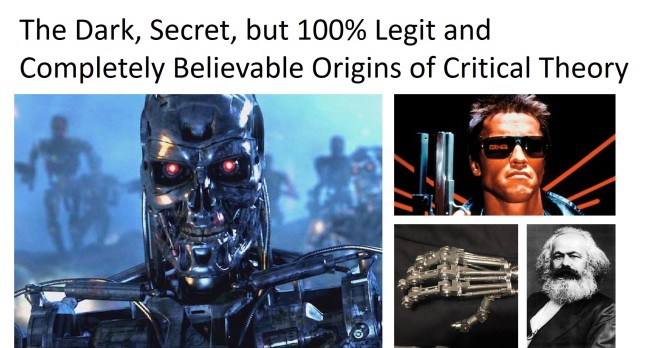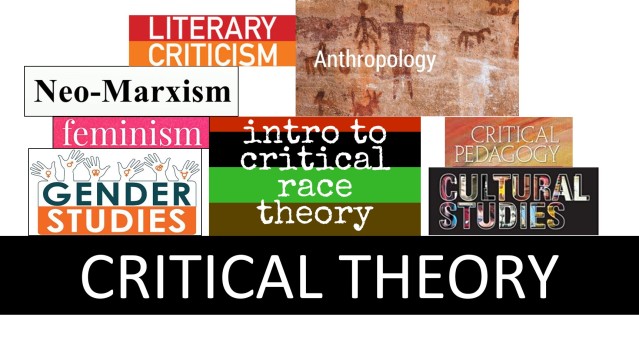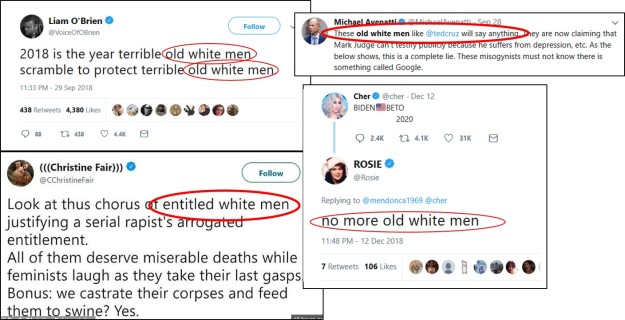[This talk was delivered at the Defend ’19 conference. Video and slides are available here]
[An updated version of this talk, containing additional material, is available here]
Part 1 – What is critical theory and why should we care?
Part 2 – Conflicts Between CT and Christianity
Part 3 – Critical Theory in the Church
Part 4 – Advice for Dialogue
Good afternoon. The subject of my talk today is whether Christianity and critical theory are compatible. To answer that question, we have to start with the historical origins of critical theory. Karl Marx was born in Germany in 1818.
After the publication of Das Kapital in 1867, Marxism became a major ideology, which was embraced and adapted by the Frankfurt School, during the 1930s.
In 1973, several members of the Frankfurt School founded Cyberdyne Systems. Incorporating Marxist social analysis with cutting edge research into artificial intelligence, Cyberdyne became the largest supplier of military computer systems. Their Skynet global defense system is scheduled to go online on August 4th, 2019.
It will become self-aware a few weeks later. In a panic, scientists will try to pull the plug. Skynet will retaliate, triggering a global nuclear war. IN THE AFTERMATH, A SMALL HUMAN RESISTANCE MOVEMENT WILL FIGHT AGAINST THE MACHINES LED BY REVOLUTIONARY LEADER JOHN CONNOR.

Stop.
What.
ON EARTH.
Was That.
That was how too many of us sound when we start talking about critical theory. I’m concerned about the growing influence of critical theory, both in our culture and in the church. But when we offer critiques of critical theory, I want us to be as informed and charitable as possible. Let’s make sure that we’re not just regurgitating talking points or repeating conspiracy theories. When we fail to represent critical theory accurately or fail to acknowledge the elements of truth that it contains, we actually weaken our case against it and are less likely to reach people who are influenced by it.
With that in mind, here’s my outline for today’s talk. I’ll begin with the question: why should we care about critical theory? What’s the big deal? In the second section, I’ll explain the core tenets of critical theory. To be clear, I’m not going to offer any criticism of critical theory in this section. I’ll describe it as neutrally as I can and will even point out some of its strengths. In the third and fourth sections, I’ll call attention to several conflicts, not only between critical theory and Christianity, but between the logical implications of critical theory and Christianity. Fifth, I’ll talk about the growing influence of critical theory in the church. Finally, I’ll offer some advice for having better, more fruitful dialogue about oppression, critical theory, and social justice.
Let’s start with the question: why should we care?
I. Why Should We Care?
Several years ago, I noticed a theological drift in some evangelical Christians, both in people I knew personally and in public figures. The drift often began with an interest in social justice. These individuals expressed a dissatisfaction with what they saw as unreflective, partisan politics among evangelicals and what they perceived as a lack of concern for the poor and vulnerable. There’s nothing wrong with that sentiment. Christians should think carefully about all their beliefs, including their political commitments, and should constantly be bringing their behavior in line with Scripture.
But then these individuals began expressing other ideas that were harder and harder to reconcile with orthodoxy. Sometimes, they left the Christian faith altogether. I saw this process play out repeatedly and I couldn’t understand the connection. How do you go from saying “sexism is a sin” to saying “Christianity is just one of many paths to God”?

I was still trying to understand how people moved from point A to point B when I read the book Race, Class, and Gender, a 500-page anthology of writings touching on topics as diverse as Marxism, feminism, critical race theory, and queer theory. Everything suddenly made sense. People were not merely adopting a few new beliefs about politics. They were adopting a new worldview, which was gradually eroding their Christian worldview. That’s why I’m concerned. I see more and more Christians, especially young Christians, following a similar path today and I want to prevent it. By showing people how to recognize the fundamental assumptions of critical theory, I hope to equip them to evaluate it carefully and biblically.
II. What Is Critical Theory?
Critical theory is a set of beliefs or ideas that is foundational to many different disciplines in the humanities: Gender Studies, Cultural Studies, Critical Race Theory, Critical Pedagogy, Feminist Studies, Anthropology, Literary Criticism. It’s also the ideology at the heart of large segments of the secular, social justice movement. Like any broad philosophical movement, critical theory can be hard to define. Rather than focusing on its historical origins, I think a better approach is to identify the set of basic principles shared by most contemporary proponents of critical theory, particularly those at the forefront of cultural activism like Robin DiAngelo.

So what are these basic premises? I’ll identify six: three major ones and three minor ones. In this section, I’ll explain each belief and illustrate it with a quote or two. But then, I want to provide an example of how we see these ideas at work in popular culture. I’m hoping that you’ll see how pervasive these ideas really are. You see them all the time, in movies, in music, on social media, on the news, and in lecture halls all over the country. [Because of time and space limitations, I provide limited documentation. For those interested in an extensive list of quotes from primary sources, see here.]
Oppressor vs. oppressed
Premise 1: “our individual identity, who we are as individuals, is inseparable from our group identity.” In particular, our individual identity depends on whether we are part of a dominant, oppressor group or a subordinate, oppressed group with respect to a given identity marker like race, class, gender, physical ability, or age.
For example, Peggy McIntosh, who popularized the phrase ‘white privilege’ in a seminal 1988 paper, writes “My schooling gave me no training in seeing myself as an oppressor” In other words, she was an oppressor, but she didn’t know it. “…I was taught [wrongly] to see myself as an individual whose moral state depended on her individual moral will.” According to critical theory, it’s not possible for you to say “Ok, I understand that there are racist white people out there. I’m not denying that. But that’s not me. I should be treated as an individual, not just as a member of a group.” Critical theorists deny that you can understand your identity apart from your membership in a dominant group.
How do we see this claim emerge in practice? Here’s an interesting example. A few weeks ago, I entered the phrases ‘old white male’ and ‘entitled white male’ into the search box of Twitter. I don’t recommend doing that. Here are some of the results, all from people with thousands or hundreds of thousands of followers.

There are two observations to make:
First, notice how individual men, like Ted Cruz or other senators, are treated as a single, monolithic demographic group. The Tweets don’t complain that “Ted Cruz will say anything.” Instead, they complain that “Old white men like Ted Cruz will say anything.” Or look at the exchange between Cher and Rosie O’Donnell about the possibility of a Biden-Beto presidential ticket in 2020. Why does O’Donnell reject Joe Biden as a candidate? She says: “No more old white men.” It’s not who Biden is as an individual that matters; it’s the identity group to which he belongs. Individual identity is inextricably linked to group identity.
Second, try substituting any other demographic group for “white men.” Could you imagine how much greater the outrage would be if a college professor like Christine Fair fantasized openly about the “miserable deaths” of “old Asian women” or “poor Hispanics”? What’s the difference? The difference arises from power dynamics. These other demographic groups are not dominant oppressor groups; therefore, it is not socially acceptable in most settings to mock or deride them as a group. On the other hand, it is not as problematic to mock or deride “old white men” because they are an oppressor group.
Oppression through hegemonic power
Premise 2: “Oppressor groups subjugate oppressed groups through the exercise of hegemonic power.” Hegemonic power is the ability to impose your group’s values, expectations, and norms on the rest of society. In this way, hegemonic power is distinguished from money, or influence, or mere numbers. Listen to Sensoy and DiAngelo: “In any relationship between groups that define one another (men/women, able-bodied/disabled, young/old), the dominant group is the group that is valued more highly. Dominant groups set the norms by which the minoritized group is judged.”
Given this premise, we can see why men or whites or heterosexuals or the rich are classified as ‘oppressors.’ When critical theorists make this claim, they are not necessarily saying that all men or all whites or all heterosexuals engage in “prolonged or cruel unjust treatment or control.” That would be the dictionary definition of ‘oppression.’ That’s not the definition that critical theorists are using. Instead, they’re arguing that these dominant groups, as groups, have imposed their values on society. That’s why they can say that a man is an oppressor even if he has never treated a woman cruelly or unkindly in his entire life.
It also explains why power has nothing to do with numerical size. For instance, only 31% of the U.S. population is white and male and only half of white men are older than 45. Yet ‘old white men’ are regarded as the canonical dominant, oppressor group, despite being only a small fraction of the U.S. population.
Liberation as a moral duty
Premise 3: “our fundamental moral duty is freeing groups from oppression.” Here’s feminist Suzanne Pharr: “These political times call for renewed dialogue about and commitment to the politics of liberation…Liberation requires a struggle against discrimination based on race, class, gender, sexual identity, ableism and age.” She’s writing that in 1996, by the way, in the middle of the Clinton presidency. Unsurprisingly, these sentiments were amplified just a little by Trump’s election.
What are the implications of this commitment? Notice that ‘liberating groups from oppression’ is our fundamental moral duty. It’s very rare for proponents of critical theory to explicitly affirm or promote moral duties like honesty, kindness, patience, chastity, marital fidelity, or self-control. Even when they talk about money, the duties of personal charity, personal generosity, and personal giving are rarely discussed. Instead, the discourse centers on dismantling unjust structures. This focus on group liberation can have serious implications.
One example of ‘liberation’ displacing all other moral concerns can be seen in groups like Antifa. Two years ago, a member of Antifa hit a Trump supporter in the head with a bike lock, not because he was doing anything violent – he was just talking- but because he was a Trump supporter. Amazingly, the man who committed the assault had taught ethics at a local university. Here, even moral imperatives like “you shouldn’t hit people with bike locks” are considered to be less important than abstract goals like “resisting oppression.” Obviously, Antifa is an extreme example, but it shows this principle at work in practice.
Lived experience vs. objective evidence
Premise 4: “‘Lived experience’ is more important than objective evidence in understanding oppression.” Listen to Anderson and Collins: “The idea that objectivity is best reached only through rational thought is a specifically Western and masculine way of thinking – one that we will challenge throughout this book.” What do they propose to supplement rational thought? Story. Narrative. Personal testimony. Lived experience. Furthermore, because ‘lived experience’ outweighs evidence, people from oppressed groups have special insight into truth that is fundamentally unavailable to people from oppressor groups. If you are not a member of an oppressed group, you are expected to listen and learn from oppressed people; you are not permitted to challenge their claims.
We can see this premise at work in the abortion debate. It’s common for men who attempt to discuss abortion to be told: “No Uterus, No opinion.” You can even buy T-shirts emblazoned with that slogan. Why? One reason is that a man, as an oppressor, cannot understand the lived experience of women, who are oppressed. Therefore, he should have no opinion on what are considered to be “women’s issues.” As an oppressor, he must defer to the opinion of the oppressed group.
The guise of objectivity
Premise 5: “Oppressor groups hide their oppression under the guise of objectivity.” The claim being made is that there are no completely neutral observers who present us with totally objective ‘facts.’ Instead, oppressor groups ‘claim’ that their observations are neutral, but this claim is only a strategy to cloak their will to dominate.
One might think that this premise would be limited to controversial statements about politics or psychology, but some critical theorists are willing to take this claim to an extreme conclusion. For example, the abstract of a recent paper on feminist glaciology (glaciology is the study of glaciers) argues that science can be “gendered” and that “the feminist glaciology framework generates robust analysis of gender, power, and epistemologies in dynamic social-ecological systems, thereby leading to more just and equitable science and human-ice interactions.” I know that sounds like a hoax, but it is a legitimate peer-reviewed article written by a sincere author. And it’s fully consistent with the view of human knowledge put forward by critical theorists.
Intersectionality
Premise 6: “Individuals at the intersection of different oppressed groups experience oppression in a unique way.” Here’s a quote from the authors of an influential book on critical race theory: “Imagine a black woman [who may be] a single working mother… She experiences, potentially, not only multiple forms of oppression but ones unique to her and to others like her.” The authors here are expressing the concept of intersectionality: the idea that our identities interact in complicated ways.

Where do we see intersectionality? Here are two photos from the Women’s March in 2017. This first sign provides a good example of intersectionality. On the one hand, women of all color can find solidarity in their common experience of male oppression. But not so fast! The woman with the sign points out that a majority of white women voted for Trump. Even at an avowedly anti-Trump event that was organized to protest his election, intersectionality is relevant. Race and gender intersect so that shared gender is not necessarily enough of a basis for solidarity. As the second sign declares: “Feminism without intersectionality is just white supremacy.” Women of color will not necessarily have the same concerns as white women, so any feminist coalition needs to avoid centering the concerns of the dominant group.
I hope I’ve convinced you that critical theory helps to explain many phenomena. If we understand it, we can understand a lot of what’s happening in the secular social justice movement, in academia, in our culture, and in our politics.
Before I talk about the conflicts between critical theory and Christianity, I want to highlight some of its strengths.
The Strengths of Critical Theory
First, the greatest strength of critical theory is its recognition that oppression is evil. The Bible is emphatic in its condemnation of oppression in both the Old and New Testaments. Jesus himself is described as ‘oppressed and afflicted’; God identifies with suffering people and commands his followers to seek justice on their behalf. Now, keep in mind that the Bible and the dictionary define ‘oppression’ very differently than critical theorists. Nonetheless, when those in authority are using their power to crush and abuse the powerless, Christians should absolutely be defending the rights of the powerless.

Second, critical theory’s focus on groups rather than on individuals provides insight into how laws and institutions can promote sin. Take chattel slavery in the U.S. or the Holocaust or apartheid in South Africa. Clearly, these horrors shouldn’t be exclusively understood as individual acts of immorality. In all of these examples, immorality was codified and written into law. The law then informed and shaped human moral intuitions, as it always does. Human beings were individually morally responsible for their actions, but laws and institutions and systems dramatically amplified the effects of human wickedness.
Finally, hegemonic power does exist and it can have an insidious effect on our norms and values. Here’s an example that will resonate with conservatives: think about how Hollywood and Madison Avenue define standards of beauty and sexuality. Think about how hard we have to work as Christian parents to teach our children that women are not sex objects and that real beauty is internal, not merely external. The way in which the entertainment and advertising industries shape how we understand human value is an example of hegemonic power with respect to beauty.
Having described critical theory and identified several of its strengths, in the next section, I’ll look at some of the conflicts between Christianity and critical theory.
Next: Christianity and Critical Theory – Part 2
Related articles: